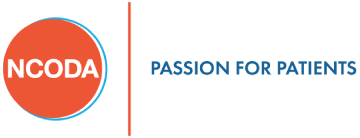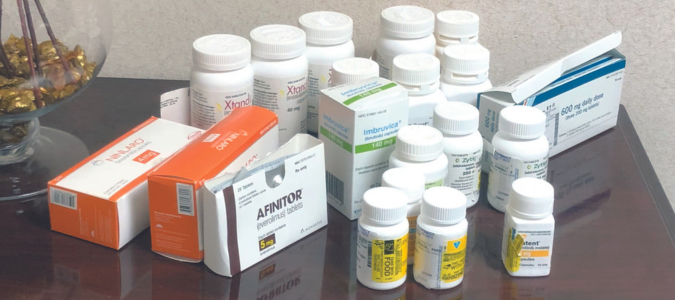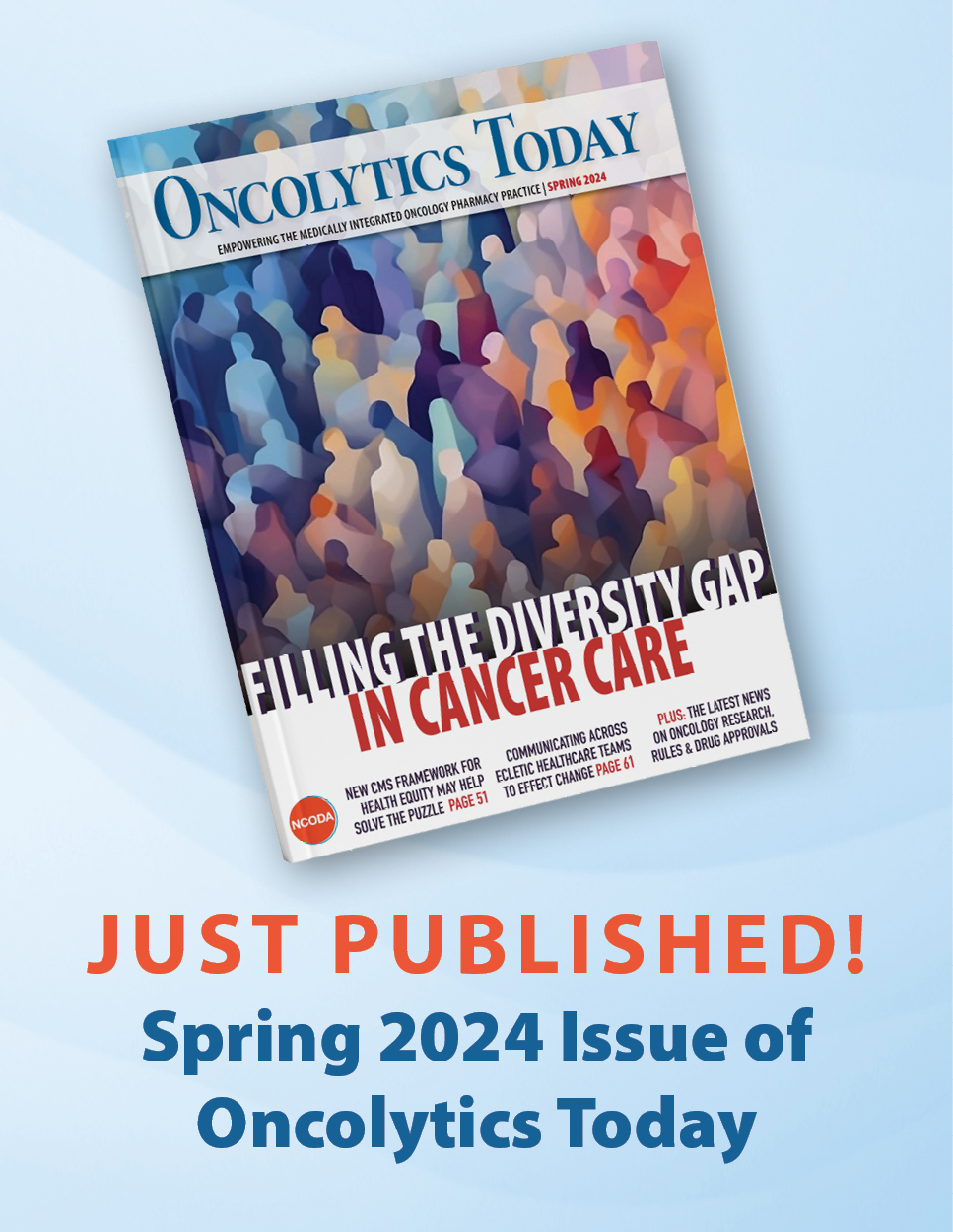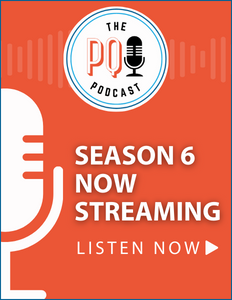HOW 5 NCODA PRACTICES WERE EMPOWERED TO TAKE THE NEXT STEP IN IMPROVING PATIENT CARE
By Bill Wimbiscus
Oncolytics Today Editor
There’s a moment in the life of nearly every oral oncology patient, a moment that can have a profound effect on their treatment outcome.
That moment occurs immediately after the “first fill” of their chemotherapy prescription by a local pharmacist. At that point, all future fills will follow one of two paths:
- The first requires a patient unfamiliar with their own situation and a phone representative unfamiliar with the patient to manage prescriptions while reacting to dosage changes and side effects, placing only minimal emphasis on related issues, such as adherence and financial toxicity.
- The second enables an integrated team of physicians, nurses, pharmacists, technicians and financial specialists intimately connected with the patient to monitor and anticipate dosage, side effect, adherence and financial toxicity issues.
It’s no surprise that the second path leads to better outcomes for all involved, noted Michael Reff, Executive Director and Founder of NCODA.
“It’s a win-win-win-win proposition,” said Reff. “It’s a win for the patient because they receive timely therapy, continuity of care and personalized treatment. It’s a win for the practice because they have better managed patients. It’s a win for the payer because they get superior drug utilization and less waste. Lastly, it’s a win for stakeholders like the pharmaceutical industry because they get better clinical results for their innovative products.”
Unfortunately the decision on whether an oral chemotherapy prescription will be filled by a mail-order pharmacy or a local pharmacy usually isn’t up to the patient; it’s up to their insurance carrier.
But most commercial payers – whether by contract, business structure or simply habit – require prescriptions to be managed by a mail-order pharmacy. In some cases, a mail-order pharmacy affiliated or even owned by the payer – and one that only can be reached by phone.
PHONE FRUSTRATIONS
Now talking, or trying to talk, to a customer service representative over the phone can be a frustrating experience. Anyone who owns a computer, appliance or an insurance policy has dealt with the frustration of navigating phone banks, call queues and hang-ups only to reach someone who either doesn’t understand their concerns or doesn’t have the authority to resolve them.
It was one such experience that convinced Reff that there had to be a better way to deliver desperately needed oral oncology to the practice’s patients.
“Back in 2013, we had a glioblastoma patient on radiation with Temodar. She’s in a wheelchair and it’s 4:30 Friday afternoon. She tries to get a refill, but the insurance company rep says we can’t do it here even though I have the prescription ready; she has to go through their mail-order pharmacy.
“But the mail order can’t get it to her until next Thursday at the earliest, and she’s due for radiation Monday. So her husband finally says, ‘How much is it to fill it here? I’ll pay for it.’ The insurance rep eventually agrees to let us fill it, but only for co-pay of $1,000, basically a penalty for filling out-of-network.
“The poor woman was already battling a terminal diagnosis, and to think that I had the drug and all they had to do was touch a couple of buttons on their end to make it better for her … it was crazy. After about 20 minutes of demanding, I finally talked to the rep’s supervisor. They eventually gave the patient an override, allowing us to fill her script without the penalties and a minimal copay.”
Reff’s experience is not unique. Talk to just about any oncology care provider across the country, and likely they’ll have encountered the same problem while trying to secure vital oral prescriptions for their patients.
GOING BEYOND THE FIRST FILL
That’s why NCODA established “Beyond the First Fill,” a benchmark initiative for positive patient care outcomes at the practice level based on NCODA Quality Standards.
Beyond the First Fill encourages member practices to adopt NCODA Quality Standards and collaborate with payers and employer groups to authorize the practice’s own medically integrated pharmacy to dispense oral chemotherapy to their patients. In other words, prescriptions stay within the practice, rather being routed out to a mail-order pharmacy.
“Beyond the First Fill supports better patient care,” Reff said. “There is a value proposition to keeping it in-house. It’s more convenient for the patient, their speed to therapy is quicker, follow-up is more efficient, adherence is enhanced and the economics are better for all concerned.”
Jonas Congelli, RPh, Director of Pharmacy Services at Hematology Oncology Associates of Central New York (HOACNY) in Syracuse, was an early advocate of what has come to be called the medically integrated team approach, also known as medically integrated pharmacy. He worked with Reff in 2013 to pioneer the concept after becoming exasperated with the existing dispensing system.
“It didn’t take very long to realize that the current system with Pharmacy Benefit Managers and mail-order pharmacies didn’t make sense for oncology,” Congelli said. “There’s so many things that go into the treatment of a patient with cancer; there’s just no way a mail order can react to them.”
The mail-order model’s slow reaction time causes a host of problems, Congelli noted. New prescriptions and dosage changes can’t get filled quickly enough. Patients end up waiting for vital therapy, sometimes receiving out-of-date fills, the wrong dosage or even the wrong medication, resulting in treatment complications, as well as unnecessary waste and expense.
The solution? Establish a more intimate relationship between provider, pharmacist, patient and payer, one that allows oral chemotherapy to be dispensed directly through the practice rather than a mail-order pharmacy.
Reff and Congelli addressed the front end of the relationship issue by establishing a trio of experts – a pharmacist, a pharmacy technician and a nurse – to help coordinate patient care throughout the practice. Keeping all aspects of treatment within the practice, they believed, would deliver better patient care, at a lower cost and with improved patient satisfaction.
The new system proved to be a hit from the start. Providers and patients appreciated the HOACNY’s streamlined, integrated approach to oral oncology therapy.
“Once it was in place, it quickly became very clear how powerful it was,” Anthony Scalzo, MD, President of HOACNY, said. “One sign of success was the benefit to the patient. There was no longer a question of a drug being available on time; if I changed a dose, there was never a lapse in treatment. Plus, our patients were better educated regarding their treatment and its possible side effects.
“From a business perspective, it was also good for the practice. We do make a margin on these medications, but part of it goes into overhead. At the same time we are providing a tremendous amount of expertise towards patient care and I think that’s a fair exchange.”
OVERCOMING THE PAYER HURDLE
Yet for all its initial accolades, the fledgling medically integrated team approach still faced one significant hurdle: the payers. That’s because nearly every commercial insurance carrier required oral chemotherapy to be filled by a mail-order pharmacy.
“We were initially a little naïve about the way the system truly operates and the hold that Pharmacy Benefit Managers and mail-orders have on it,” Congelli said. “What we found was that almost all the insurance companies had agreements with mail-order pharmacies, especially for expensive drugs. Within months of opening we realized we needed to do something about the inadequacies of that system.”
Yet when Congelli and Reff began pushing for a medically integrated team option with payers, they met resistance; it just wasn’t the way most health insurance carriers were used to doing things.
Reff compared the experience to that of convincing an office manager that a word processor was a better alternative than typewriter.
“Their initial attitude was generally one of ‘if it ain’t broke, why fix it?’” Reff recalled. “It took a lot of time to explain that our way not only provided better patient care, but also delivered it with a lot less waste, a lot fewer unnecessary costs and much greater patient satisfaction.”
Part of that explanation involved showing the value propositions of the medically integrated team model. And one of the most compelling arguments for the new model involved documentation of both mail-order waste and the medically integrated team’s unique ability to avoid unnecessary costs.
“Decreasing waste and avoiding cost is a one-two punch,” Reff explained. “You avoid cost by providing faster, more direct care for the patient. This, in turn provides better patient outcomes, and helps avoid high-cost events, such as emergency room visits and hospitalization.
“You eliminate waste by avoiding unnecessary prescriptions. Should the patient’s condition call for a higher or lower dosage or even a change in medication, a medically integrated pharmacy is able to respond immediately, keeping waste to a minimum or avoiding it altogether.”
SHOW AND TELL
But it wasn’t enough just to tell payers about waste and cost avoidance; Reff and Congelli quickly realized they needed a way to show it.
So in 2014 HOACNY’s new integrated team began actively documenting mail-order pharmacy waste, actually saving bottles of pills returned by patients because they were either an out-of-date or incorrect dosage, or, in some cases, even the wrong prescription.
“Over the years I couldn’t even tell you how much medicine we’ve ended up throwing away,” Congelli said. “It’s kind of sad; the payers have paid for it, but no one is going be able to use them. Payers think they’re getting a good rate up front, but they don’t see the waste on the back end.”
At the same time, the pair realized it was important to get patient feedback to document the effectiveness of the new system. So Reff created a method to generate direct and immediate response.
“I began handing out satisfaction surveys to our patients when they came to pick up their prescriptions,” Reff said. “They filled them out and handed them back in.”
In this way, Reff was able to collect several hundred patient satisfaction surveys. The response: overwhelmingly positive.
Armed with both the survey data and a big bag of wasted prescriptions, Congelli and Reff were able to finally convince HOACNY’s largest regional insurance carrier and another smaller payer that medically integrated team approach provided better care at a lower cost and with greater patient satisfaction than the conventional mail order system.
FLORIDA FIRST
Yet years before HOACNY even began working on its new oral oncology concept, another group – Florida Cancer Specialists & Research Institute (FCS) – had already established its own “value based” model.
With 230 doctors at nearly 100 sites (including many clinical trial sites), FCS is the largest privately-held independent oncology practice in the United States. Ray Bailey, RPh, serves as Pharmacy Director.
“Our oral oncology pharmacy, Rx To Go, opened in 2008, so it’s been going for more than 10 years now,” Bailey said. “Back then there were maybe six or seven oral drugs. But then the whole landscape just exploded. We saw it coming, because we were participating in many of the clinical trials.”
Like the medically integrated pharmacy model, the FCS value-based protocol calls for an integrated team of doctors, nurses, pharmacists and technicians to coordinate patient care, as well as a squad of specialists working to help patients access financial assistance. Over the last decade, its superior value for oral chemotherapy patients has been proven time and time again.
Like HOACNY, FCS recognized from the start that the emerging oral therapies had an enormous price tag and a profound effect on the cost on insurance and a patient’s co-pay.
“Every patient has different insurance dynamics that affect whether or not they can afford their medicine,” Bailey explained. “And the industry constantly is trying to shift cost onto the patient.” He’s quick to blame the Pharmacy Benefit Managers plan design for many of the faults in the conventional payer structure for oncology patients on oral regimens.
“We’ve been pushing back on PBMs for our patients the whole time,” Bailey noted. “They have for years designed and sold pharmacy benefits packages to their customers that benefit their own mail order pharmacies. Patients cannot choose to stay inside the practice and be cared for by our medically integrated pharmacy model in many cases.”
Still, unlike HOACNY, FCS had an easier time negotiating its value-based model into their contracts.
“We’re a large practice, so payers want to work with us to bend the cost curve of oncology care,” Bailey explained. “Our efforts to improve patient compliance and outcomes also offer the benefit of waste avoidance strategies and effectively managing patients in home inventory of expensive oral medications.”
FCS was able to negotiate contracts with Blue Cross Blue Shield Florida, United Healthcare and Cigna. Nearly 60 percent of its commercial patients now can take advantage of the group’s valued-based system.
“We go at risk for shared savings in these models,” Bailey noted. “We must be able to manage the oral regimens just as we do the infusion regimens. Often oral and infusion drugs are combined in regimens adding to the complexity of patient management.”
FCS President and Managing Physician Lucio N. Gordan, MD, said Rx To Go has been a great asset for the practice, both from the perspective of patient care and the business overall.
“For the patient, it has helped deliver prescriptions on a timely basis,” Dr. Gordan said. “I don’t think there’s another pharmacy that can deliver faster than Rx To Go; it’s way ahead of the PBM approach. Plus our adherence program puts quality on the forefront.
“From a physician’s perspective, it can be challenging to keep up with all the literature, side effects and specific treatment plans of the new and ever-increasing oral therapies. No matter how much you study, there’s no way to absorb all the literature.
“Being able to work directly with our pharmacists is a tremendous help and important resource. For instance, after I prescribed a dose of a new oral this week, I got a call from our pharmacist suggesting that I should consider a different dose due to drug interaction. This is incredibly relevant and improves safety, adherence and outcomes.”
Finally, FCS’ value-based system also has been successful from a business perspective, Gordan noted. “It’s an important part of our business portfolio and has been financially positive,” he said. “But again, it’s truly more tied to improving patient outcomes.”
FCS’s oral chemotherapy standards proved to be a natural fit with those of NCODA; the practice has been an active member of the organization since 2015.
FIGHTING FOR ACCEPTANCE
In January 2015, New York Oncology Hematology (NYOH), a seven-site practice in the Albany area, became the next practice to adopt the medically integrated team model.
“I heard HOACNY was opening up a dispensing pharmacy,” recalled NYOH Area Manager of Pharmacy Services Nancy Egerton, PharmD, BCOP. “So when I was looking to set it up here in Albany, I called Jonas and Mike and asked them for a tour. They gave me a good bird’s-eye view of how they did things.”
Egerton said it was apparent from the start that the medically integrated team approach would get meds to patients quicker, improve patient education and reduce waste. But, again, the biggest challenge proved to be convincing the payers.
“We started filling and once we came up with a problem that we couldn’t fix, we contacted the insurance companies and tried to work it out,” Egerton said. “Some worked with us immediately, others waited.”
In the end, she was able to get clearance from six or seven payers – mostly regional HMOs – that covered about 60 percent of NYOH’s commercial patient base.
“The unfortunate part is our biggest commercial payer still has the restriction that we use their specialty pharmacy,” Egerton said. “We have certain scenarios where I still can’t go beyond the first fill.”
NYOH patients that are able to take advantage of the medically integrated dispensary model are ecstatic about the speed and convenience of the new system, especially its financial assistance component.
Jean Morris was diagnosed with metastatic breast cancer in April 2018. After undergoing radiation therapy, she was prescribed Ibrance, an oral drug that costs about $15,000 per month.
“When I heard the cost, I knew I couldn’t afford it,” said Morris. “NYOH making me aware that I qualified for assistance was a matter of life and death, because if I hadn’t qualified, I wouldn’t be taking it. It just blows me away because I didn’t even initiate (the assistance process).”
Prior Authorization Supervisor Gina Boilard provides financial counseling to NYOH patients. In 2018, Boilard and her team brought in more than $750,000 in copay grants.
“I get patients in tears, but I try to tell them they are in good hands,” Boilard said. “As long as their income guidelines are met, I can help them.”
EMBRACING INTEGRATION
Still, not all insurance carriers have to be convinced of the value of the medically integrated pharmacy model; some actually embrace its patient care and cost-saving benefits.
In 2016, for instance, Blue Cross Blue Shield of South Carolina approached South Carolina Oncology Associates (SCOA), the largest practice in the state, about participating in the Oncology Care Model initiative. The initiative, part of the Affordable Care Act, was specifically created to reduce the cost of cancer care.
Jan Montgomery, PharmD, SCOA’s Director of Pharmacy, was part of that process.
“The only way to affect the cost of care that we could see was to reduce hospitalizations and reduce the cost of chemotherapy,” Montgomery said. “You can keep people out of the hospital by bringing them into the clinic and treating them there. We knew we could do that, but we couldn’t reduce the cost of IV drugs; there was no room to move. The only place we saw that we could really make a difference was on the oral side, which we were totally cut out of.
“We wanted orals included in the contract, so of course this was a point of discussion. But BCBS said they could not open their PBM network to us because of a contractual obligation. It took many back and forth meetings, along with our very eye-opening presentation to educate them about our abilities and to show that waste was a problem.”
Montgomery’s presentation included having payer representatives tour the practice and dispensary, plus giving them a look at her own “big bag of wasted drugs” returned by mail-order patients.
“We’re talking $30,000 worth of waste, and that was on just one patient,” Montgomery said.
The collaboration process ended up taking about a year and a half. In the meantime, SCOA brainstormed new ideas, such as “short scripting” as opposed to the 30- to 90-day fills that were being offered by many of the mail-orders.
“We’ll dispense a two-week supply, and then give the patient a chance to come back in, see the doctor and get it filled again,” Montgomery explained. “We’ll do this four or five times until we get it right.”
Finally, after speaking with the carrier’s medical director, SCOA was given permission to dispense oral oncolytics to BCBS SC members.
“We stand tall with all the PBMs,” Montgomery said. “We’re here and we do it better. We give the warm and fuzzy: patient assistance, foundations, etc. We have everything to offer that a big PBM has, plus the electronic medical records, as well as the personal touch because we see the patient face-to-face.”
SOMETIMES IT JUST TAKES A PHONE CALL
Still, not all contract negotiations take months to accomplish.
After hearing about NCODA’s successes in late 2015, Neil Nebughr, then-Director of Pharmaceutical Services at Utah Cancer Specialists (UCS) of Salt Lake City, started calling payers.
“Just being able to talk to our payers was phenomenal,” Nebughr, RPh, said, noting that his first call was an easy one.
“Regency Blue Cross Blue Shield told me we were in network and could keep all our scripts in-house,” Nebughr said.
The next two took a little more work. With one payer, UCS had to wait for the contract to open up. In the other, the practice had to agree to take less reimbursement to become a specialty pharmacy in the payer’s contract.
“But I thought it was worth it to be able to manage our patients in-house,” Nebughr said. “It really was a benefit to our patients and it definitely increased our volume. We had to pay more attention to our reimbursement rates, but it really wasn’t a huge change.”
TIME TO TAKE THAT NEXT STEP?
As NCODA continues to grow, Reff plans to emphasize the message of Beyond the First Fill to oncology practices that are committed to better patient care.
“Going Beyond the First Fill supports better patient care,” Reff explained. “Practices understand that when the script leaves their hands and goes to a mail order pharmacy, they’re losing control of caring for their patient.
“That’s why the medically integrated pharmacy is so important; as I said before, it’s a win-win-win-win proposition. But it doesn’t happen by itself. First there has to be a passion to make the change, a commitment. You have to put the energy into making it happen.”
NCODA established its patient-centered Quality Standards to help guide practices seeking to establish medically integrated pharmacies. Those standards – along with tools such as Cost Avoidance & Waste Tracker, Patient Satisfaction Surveys and Oral Chemotherapy Education Sheets – provide the groundwork for practices that are ready to move forward.
Since its inception, NCODA has helped eight practices collaborate with 16 payers and employers to go Beyond The First Fill. In the coming months, the organization will continue to actively work with other NCODA practices ready to take the next step toward improving patient care.
NCODA QUALITY STANDARDS: A ROADMAP FOR SUCCESS
In collaboration with practices, payers and employer groups, NCODA has created the following patient-centered quality standards as a road map for success for practices establishing a Medically Integrated Pharmacy:
Patient-Center Quality Standard: Established to provide exceptional patient care, this standard focuses on maximizing patient convenience, providing timely access to treatment, monitoring patient adherence, ensuring financial support and delivering individualized patient education. For more information, visit www.ncoda.org/wp-content/uploads/2018/06/patientcenteredqualitystandards.pdf
Positive Quality Interventions (PQIs) Quality Standard: Utilizes the Electronic Medical Record, pharmacy software and other available resources to ensure patient safety, as well as advocate on the patient’s behalf regarding insurance benefit investigation, coverage determination including out-of-pocket expenses, and referral to patient assistance programs and foundations. For more information, visit www.ncoda.org/wp-content/uploads/2018/06/positivequalityinterventions1.pdf
Foundational Elements Quality Standard: Outlines establishment of a mission statement, organizational chart, business plan, readiness tracker, operational elements, dispensing space, communication plan and standard operating procedures. For more information, visit www.ncoda.org/wp-content/uploads/2018/06/3foundationalelements1.pdf
Health Information Technology Quality Standard: Extrapolates data from prescriptions, first fill rates, first month discontinuation rates, reasons for discontinuations, adverse drug reactions, drug waste, cost avoidance and financial support tracking to achieve improved quality of patient care, including maximizing duration of therapy, dose intensity and adherence, while reducing adverse drug reactions and waste. For more information, visit www.ncoda.org/wp-content/uploads/2018/06/4healthinformationtechnology1.pdf
